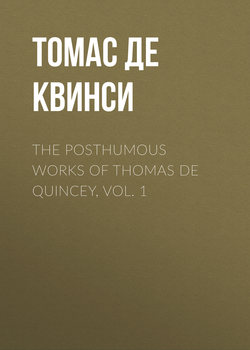Читать книгу The Posthumous Works of Thomas De Quincey, Vol. 1 - Томас Де Квинси - Страница 3
DE QUINCEY'S POSTHUMOUS WORKS
I. SUSPIRIA DE PROFUNDIS
ОглавлениеIntroduction, with Complete List of the 'Suspiria.'
The finale to the first part of the 'Suspiria,' as we find from a note of the author's own, was to include 'The Dark Interpreter,' 'The Spectre of the Brocken,' and 'Savannah-la-Mar.' The references to 'The Dark Interpreter' in the latter would thus become intelligible, as the reader is not there in any full sense informed who the 'Dark Interpreter' was; and the piece, recovered from his MSS. and now printed, may thus be regarded as having a special value for De Quincey students, and, indeed, for readers generally. In Blackwood's Magazine he did indeed interpolate a sentence or two, and these were reproduced in the American edition of the works (Fields's); but they are so slight and general compared with the complete 'Suspiria' now presented, that they do not in any way detract from its originality and value.
The master-idea of the 'Suspiria' is the power which lies in suffering, in agony unuttered and unutterable, to develop the intellect and the spirit of man; to open these to the ineffable conceptions of the infinite, and to some discernment, otherwise impossible, of the beneficent might that lies in pain and sorrow. De Quincey seeks his symbols sometimes in natural phenomena, oftener in the creation of mighty abstractions; and the moral of all must be set forth in the burden of 'The Daughter of Lebanon,' that 'God may give by seeming to refuse.' Prose-poems, as they have been called, they are deeply philosophical, presenting under the guise of phantasy the profoundest laws of the working of the human spirit in its most terrible disciplines, and asserting for the darkest phenomena of human life some compensating elements as awakeners of hope and fear and awe. The sense of a great pariah world is ever present with him—a world of outcasts and of innocents bearing the burden of vicarious woes; and thus it is that his title is justified—Suspiria de Profundis: 'Sighs from the Depths.'
We find De Quincey writing in his prefatory notice to the enlarged edition of the 'Confessions' in November, 1856:
'All along I had relied upon a crowning grace, which I had reserved for the final page of this volume, in a succession of some twenty or twenty-five dreams and noon-day visions, which had arisen under the latter stage of opium influence. These have disappeared; some under circumstances which allow me a reasonable prospect of recovering them, some unaccountably, and some dishonourably. Five or six I believe were burned in a sudden conflagration which arose from the spark of a candle falling unobserved amongst a very large pile of papers in a bedroom, where I was alone and reading. Falling not on, but amongst and within the papers, the fire would soon have been ahead of conflict, and, by communicating with the slight woodwork and draperies of a bed, it would have immediately enveloped the laths of the ceiling overhead, and thus the house, far from fire-engines, would have been burned down in half-an-hour. My attention was first drawn by a sudden light upon my book; and the whole difference between a total destruction of the premises and a trivial loss (from books charred) of five guineas was due to a large Spanish cloak. This, thrown over and then drawn down tightly, by the aid of one sole person, somewhat agitated, but retaining her presence of mind, effectually extinguished the fire. Amongst the papers burned partially, but not so burned as to be absolutely irretrievable, was "The Daughter of Lebanon," and this I have printed and have intentionally placed it at the end, as appropriately closing a record in which the case of poor "Ann the Outcast" formed not only the most memorable and the most suggestively pathetic incident, but also that which, more than any other, coloured—or (more truly, I should say) shaped, moulded and remoulded, composed and decomposed—the great body of opium dreams.'
After this loss of the greater portion of the 'Suspiria' copy, De Quincey seems to have become indifferent in some degree to their continuity and relation to each other. He drew the 'Affliction of Childhood' and 'Dream Echoes,' which stood early in the order of the 'Suspiria,' into the 'Autobiographic Sketches,' and also the 'Spectre of the Brocken,' which was meant to come somewhat later in the series as originally planned; and, as we have seen, he appended 'The Daughter of Lebanon' to the 'Opium Confessions,' without any reference, save in the preface, to its really having formed part of a separate collection of dreams.
From a list found among his MSS. we are able to give the arrangement of the whole as it would have appeared had no accident occurred, and all the papers been at hand. Those followed by a cross are those which are now recovered, and those with a dagger what were reprinted either as 'Suspiria' or otherwise in Messrs. Black's editions.
